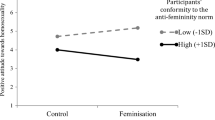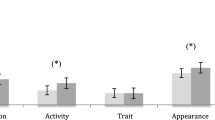Abstract
This study investigated relationships between college men's attitudes toward the male role and five theoretical concomitants of the role. It was expected that males endorsing traditional male-role norms would be more homophobic, more strongly support the Type A behavior orientation, support less self-disclosure to male and female friends, and approve of the maintenance of asymmetrical decision-making power with their intimate partner. Men from two liberal arts college in a New England metropolitan area (N=223) provided the data to test the hypotheses. Endorsement of the traditional role was associated with all predicted concomitants, expect the measure of disclosure to male friend. The results are discussed in terms of the pervasive nature of the antifemininity norm within the male role.
Similar content being viewed by others
References
Allen, D. A. Antifemininity in men. American Sociological Review, 1954, 19, 591–593.
Bell, R. R. Friendships of women and men. Psychology of Women Quarterly, 1981, 5, 402–417.
Brannon, R. The male sex role: Our culture's blueprint for manhood, what it's done for use lately. In D. David & R. Brannon (Eds.), The forty-nine percent majority: The male sex role. Reading, Mass.: Addison-Wesley, 1976. Pp. 1–45.
Brannon, R. Measuring attitudes toward women (and otherwise): A methodological critique. In J. Sherman & F. Denmark (Eds.), The psychology of women: New directions in research. New York: Psychological Dimensions, 1978. Pp. 647–691.
Brannon, R., & Juni, S. A scale for measuring attitudes about masculinity. Psychological Documents, 1984, 14, 6–7.
Broverman, I. K., Vogel, S. R., Broverman, D. M., Clarkson, F. E., & Rosenkrantz, P. S. Sex-role stereotypes: A current appraisal. Journal of Social Issues, 1972, 28, 59–78.
Caplan, R. D., Cobb, S., French, J. R. F., Van Harrison, R., & Finneau, S. R. Job demands and worker health: Main effects and occupational differences. Washington, D.C.: U.S. Government Printing Office, 1975.
Cicone, M. V., & Ruble, D. N. Beliefs about males. Journal of Social Issues, 1978, 34, 5–16.
Cozby, P. Self-disclosure: A literature review. Psychological Bulletin, 1973, 84, 73–90.
Davis, J. A. General social surveys, 1972–1980: Cumulative data. Chicago: National Opinion Research Center, 1980.
Derlega, V. J., & Chaikin, A. L. Norms affecting self-disclosure in men and women. Journal of Consulting and Clinical Psychology, 1976, 44, 376–380.
Doyle, J., & Moore, R. Attitudes toward the Male's Role Scale (AMR): An objective instrument to measure attitudes toward the male's sex role in contemporary society. JASA Catalog of Selected Documents in Psychology, 1978, 8, 35–36.
Falbo, T. PAQ types and power strategies used in intimate relationships. Psychology of Women Quarterly, 1982, 6, 399–405.
Fiebert, M. Measuring traditional and liberated males' attitudes. Perceptual and Motor Skills, 1983, 56, 83–86.
Fischer, J. L., & Narus, L. R. Sex Roles and intimacy in male sex and other sex relationships. Psychology of Women Quarterly, 1981, 5, 444–455.
Friedman, M., & Rosenman, R. Type A behavior and your heart. Greenwich, Conn.: Fawcett, 1974.
Gramick, J. Homophobia: A new challenge. Social Works, 1983, 28, 137–141.
Gross, A. E. The male role and heterosexual behavior. Journal of Social Issues, 1978, 34, 87–107
Hacker, H. M. Blabbermouth and clams: Sex differences in self-disclosure in same-sex and cross-sex friendship dyads. Psychology of Women Quarterly, 1981, 5, 385–401.
Harrison, J. Warning: The male sex role may be dangerous to your health. Journal of Social Issues, 1978, 34, 65–86.
Henley, N. M. Power, sex and nonverbal communication. In Z. Rubin (Ed.), Doing unto others: Joining, molding, conforming, helping, loving. Englewood Cliffs, N.J.: Prentice-Hall, 1973. Pp. 48–60.
Jourard, S. M. Some lethal aspects of the male role. In S. Jourard, The transparent self. New York: Van Nostrand Reinhold, 1971.
Jourard, S. M., & Lasakow, P. Some factors in self-disclosure. Journal of Abnormal and Social Psychology, 1958, 56, 91–98.
Komarovsky, M. Dilemmas of masculinity: A study of college youth. New York: Norton, 1976.
Krulewitz, J. E., & Nash, J. E. Effects of sexual attitudes and similarity on men's reaction to male homosexuals. Journal of Personality and Social Psychology, 1980, 38, 67–74.
Lehne, G. K. Homophobia among men. In D. David & R. Brannon (Eds.), The forty-nine percent majority: The male sex role. Reading, Mass.: Addison-Wesley, 1976. Pp. 66–88.
Lewis, R. A. Emotional intimacy among men. Journal of Social Issues, 1978, 34, 108–121.
Matthews, K. A. Psychological perspectives on the Type A behavior pattern. Psychological Bulletin, 1982, 91, 293–323.
Minningerode, F. A. Attitudes towards homosexuality: Feminist attitudes and social conservatism. Sex Roles, 1976, 2, 3–10.
Moore, D., & Nuttall, J. R. Perceptions of the male sex role. Personality and Social Psychology Bulletin, 1981, 7, 320–325.
Moreland, J., & Van Tuinen, M. The Attitudes Toward Masculinity Transcendence Scale. Unpublished manuscript, Department of Psychology, Ohio State University, 1978.
Morin, S. F., & Garfinkle, E. M. Male homophobia. Journal of Social Issues, 1978, 34, 29–47.
Nutt, R. L., & Sedlacek, W. E. Freshman sexual attitudes and behaviors. Journal of College Student Personnel, 1974, 15, 346–351.
Peplau, L. A. Power in dating relationships. In J. Freeman (Ed.), Women: A feminist perspective (2nd ed.). Palo Alto: Mayfield, 1979.
Pleck, J. H. Males' traditional attitudes toward women: Conceptual issues in research. In J. Sherman & F. Denmark (Eds.), The psychology of women: Future directions of research. New York: Psychological Dimensions, 1978. Pp. 619–644.
Pleck, J. H. The myth of masculinity. Cambridge, Mass.: MIT Press, 1981.
Plog, S. C. The disclosure of self in the United States and Germany. Journal of Social psychology, 1965, 65, 193–203.
Sales, S. M. Differences among individuals in affective, behavioral, biochemical, physiological responses to variations in work load. Dissertation Abstracts International, 1969, 30, 2407-B.
Sattel, J. W. The inexpressive male: Tragedy or sexual politics? Social Problems, 1976, 23, 469–477.
Sawyer, J. On male liberation. Liberation, 1970, 15, 32–33.
Smith, K. Homophobia: A tentative personality profile. Psychological Reports, 1971, 29, 1091–1094.
Turner, R. Family interaction. New York: Wiley, 1970.
Villemez, W., & Touhey, J. A measure of individual differences in sex stereotyping and sex discrimination: The “Macho” Scale. Psychological Reports, 1977, 41, 411–415.
Weinberger, L. E., & Millham, J. Attitudinal homophobia and support of traditional sex roles. Journal of Homosexuality, 1979, 4, 237–246.
Yankelovich, D. The new morality: A profile of American youth in the 70s. New York: McGraw-Hill, 1974.
Author information
Authors and Affiliations
Rights and permissions
About this article
Cite this article
Thompson, E.H., Grisanti, C. & Pleck, J.H. Attitudes toward the male role and their correlates. Sex Roles 13, 413–427 (1985). https://doi.org/10.1007/BF00287952
Issue Date:
DOI: https://doi.org/10.1007/BF00287952




